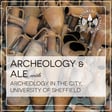
Uncovering Sheffield Castle with Milica Rajic - Ep 28
Archaeology and Ale is a monthly series of talks presented by Archaeology in the City, part of the University of Sheffield Archaeology Department’s outreach programme. In this talk, Archaeology in the City proudly presents - Milica Rajic on “Uncovering Sheffield Castle” This talk took place on Thursday, November 29th, 2019 at the Red Deer in Sheffield.
Milica is a project manager with Wessex Archaeology where she has worked since 2015. During that time she has served on the recent excavations at Sheffield's Castlegate area. In this talk, Milica takes us through a brief history of the Castle which once stood there and tells us about what the recent findings mean for the future of Sheffield Castle.
For more information about Archaeology in the City’s events and opportunities to get involved, please email archaeologyinthecity@sheffield.ac.uk or visit our website at archinthecity.wordpress.com. You can also find us on Twitter (@archinthecity), Instagram (@archaeointhecity), or Facebook (@archinthecity)
*Content Warning: Listener discretion is advised as there may be adult language*
Affiliates
